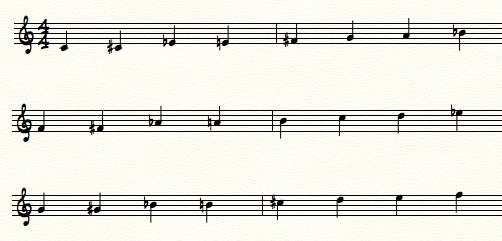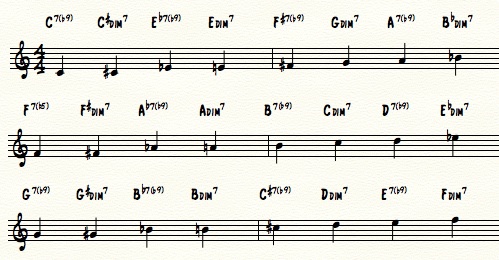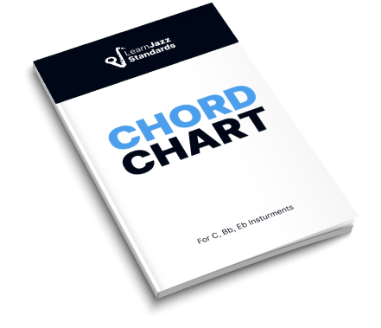There are 12 major scales. It would seem to follow there are 12 of any other type of scale, one for each chromatic note. However, this is not the case. Because of their symmetry, there are only 3 diminished scales and only 2 whole tone scales! Of course, there is only one chromatic scale. In this article, we will unlock some of the secrets of the mysterious diminished scale.
There is a movement in modern jazz theory to talk about scales in terms of “pitch collections,” which is just what it sounds like; a collection of pitches. The term is sometimes used in lieu of the word “scale” to help de-emphasize the sequential nature of a scale. Seeing the notes in a pitch collection outside of their relationship to a sequential “scale” can theoretically be a positive thing for an developing improviser seeking to play coherent melodies instead of just “using this-or-that scale to improvise.”
The term “pitch collection” is especially useful when talking about diminished harmony. Their symmetry makes diminished scales prime examples of “pitch collections” because we can easily see the repetitive nature of these scales. Each of the 3 diminished pitch collection (scales) can start (and end) on 8 different notes, corresponding to eight different chords (4 diminished chords and 4 “7(b9)” or “13(b9)” chords).
Diminished scales consist of alternating whole steps and half steps. Some people call diminished scales “Octatonic” scales, as they have 8 notes (counting the root only once). This is different from the major modes, which have only 7 notes, again counting the root only once. However, the term “Octatonic” can also be used more generally to mean an eight note scale, though it is commonly used in reference to a “diminished scale” instead of the more generic reference.
There are actually two different forms of the diminished scales, like two sides of a coin. The two forms both have alternating whole steps and half steps, but they differ in that they start with different intervals. In the two different forms below, the W stands for “whole-step” and the H stands for “half-step.” Consider the two forms of the diminished scale, noting the starting intervals:
1. Whole-half Diminished
W H W H W H W H
This is most commonly referred to as the whole-half diminished scale. This scale is especially useful for dealing with diminished chords.
2. Half-whole Diminished
H W H W H W H W
This form of the diminished scale is generally referred to as the half-whole diminished scale. This scale specifically corresponds with a 7(b9) or 13(b9) dominant chord.
People sometimes use several other names for the “half-whole” and “whole-half diminished” scales, but the other terms aren’t standardized, and are sometimes even contradictory. The most clear ways to talk about these scales is in terms of the “whole-half” and the “half-whole” diminished scales because it tells you exactly which scale you are talking about in the name. I highly recommend using these two terms because there is no consensus on what the alternate terms mean.
Confusingly, I have heard BOTH the “whole-half” and the “half-whole” diminished scales referred to as the “auxiliary diminished scale” by different sources, but since different people mean opposite things regarding the term, I would recommend steering clear of it. It’s ambiguous.
But just so you are familiar with the alternate names for these scales, the whole-half diminished scale is sometimes called the “auxiliary diminished” or just the “diminished scale”. The half-whole diminished scale is sometimes referred to as the “auxiliary diminished scale” (again, note the inherent contradiction because some people use the same term for the opposite scale!) the “auxiliary diminished dominant” or even the “auxiliary diminished blues” (not to be confused with the Mixo-Dorian blues scale for soloing over the blues). The names “whole-half diminished” and “half-whole diminished” are the most widely accepted names, probably because they are the most clear.
The three diminished pitch collections can arbitrarily be thought of as starting on C, F, and G. I will list the pitch collections in terms of the half-whole diminished scale based on C, F, and G, although I could have just as easily written out whole-half diminished scales starting on C, F, and G instead. I like to think of the diminished scale in terms of starting on C, F, and G simply because those are easy notes to remember, although these reference points are completely arbitrary. Because of the symmetry of the diminished scale, any of the notes from the three pitch collections could be replaced as the starting note for a diminished scale. Depending on your starting note, the two types of diminished scales will alternate, starting with a half-step or a whole-step as the starting interval.
If music theory has always seemed confusing to you and you wish someone would make it feel simple, our free guide will help you unlock jazz theory secrets.BEFORE YOU CONTINUE...

Here are the three diminished pitch collections, arbitrarily starting on C, F, and G:
Now, imagine that you can start and end one of these three scales on ANY of the notes in its pitch collection. (You can!) Remember that since the diminished scale has alternating half-steps and whole-steps, you can actually start on ANY note in the scale and ascend the pitch collection until you reach an octave above your starting note. Depending on your starting note, you’ll either be playing a half-whole diminished scale, or you’ll be playing a whole-half diminished scale. These two types of diminished scales alternate with one another, as in the following diagram:
Each chord represents the corresponding chord to a diminished scale starting on the root of that chord. Notice that every other note implies the same chord quality. This is an important concept: each diminished scale can start on eight different notes. Four of the starting notes will give you a half-whole diminished scale corresponding to a 7(b9) chord. The other four starting notes will give you a whole-half diminished scale corresponding to a diminished 7th chord. The diagram shows the qualities alternating with one another.
Another way of stating this concept is that each chord symbol represents the starting note of a different eight-note diminished scale from one of the three diminished pitch collections. Again, to help us think about these three pitch collections, I started them on C, F, and G. That’s just an easy way to remember it, but I could have chosen any of the 8 tones in each of the 3 pitch collection as the starting pitch. Starting on C, F, and G is simply a reference point. We could just have easily started on C, Db, and D instead.
Hopefully this helps shed some light on the mysterious diminished scale! Because of the symmetry of the scale, you can use each of the 3 diminished scales with eight different chords. Here is an example of a diminished lick used over a 7(b9) chord, for further study.
-Camden Hughes











